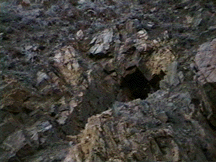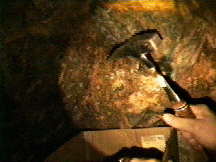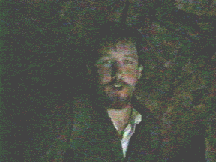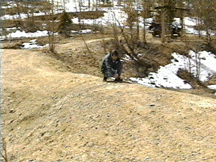
Be very careful when crossing the street to the Buckman Prospect! (Quicktime Movie 335k - No Sound)
The "Buckman Property" was one of the more interesting sites. It was an abandoned adit (exploratory mineshaft) which contained a vein of pitchblende in a "hanging wall" formation near the opening of the tunnel.
According to "Uranium Occurrences In The Golden Gate Canyon And Ralston Creek Areas, Jefferson County, Colorado", (J.W. Adams and E.P. Beroni) USGS Circular C320, pitchblende occurs at two places along the south wall of the adit. Near the portal, it forms masses as much as one-half inch thick in a shattered, iron-stained quartz vein. The pitchblende shows colloform rim structures around angular quartz fragments.
Interstitial to the pitchblende-coated quartz fragments are iron oxides, chalcopyrite, uranophane, and an unidentified green uranium mineral. A hydrated uranium sulfate, uranopilite, was identified by X-ray and optical data obtained by the Geological Survey laboratory. Although the relations are somewhat obscure, the shattered quartz in which the pitchblende is found apparently lies along a prominent shear that strikes N. 15 degrees E., and dips 40 degrees E., but no anomalous radioactivity has been found in the shear away from the quartz body.
About 45 feet along the adit, pitchblende is found in an oxidized shear striking N. 45 degrees E., and dipping 71 degrees SE. Although this shear cuts a quartz vein, the only pitchblende observed occurred a few inches outside of the quartz vein, in the adjacent sheared and silicified gneiss. Anomalous radioactivity was not detected along the shear except where the pitchblende was found.
In spite of the localization of the pitchblende in and adjacent to the quartz veins, it is doubtful that they are genetically related, and a postquartz vein origin seems more probable.
The pyrrhotite and chalcopyrite sparsely disseminated in and along the margins of the quartz veins probably are essentially contemporaneous with the quartz.

Be very careful when crossing the street to the Buckman Prospect! (Quicktime Movie 335k - No Sound)

Our mining engineer hacks into the pitchblende and collects it in a scientifically designed cardboard box. (Quicktime Movie 137k - Sound)

The area around Central City was covered with various types of old mines. A small percentage of them contain uranium bearing minerals.
According to Robert D. Niniger,
"In the Central City, Colorado, district, about 30 miles west of Denver, where fortunes were made in gold and silver during the last half of the 19th century, new deposits of pitchblende were discovered in 1948, and more have been found every year since then. Now that prospecting for uranium has started, the old-timers are saying that with a little luck the famous old mines of bygone days will again bring wealth to Central City. At least a dozen mines have recently revealed showings of uranium, some of them of commercial importance"- National Geographic. October 1954

Our mining engineer takes you right to the scene of the action. Hear the geiger counter go wild! Feel the adventure and drama!
(Quicktime Movie 516k - Sound)


Our fearless team returns from the Two Sisters Mine Dump with some record-breaking specimens! (3/23/02)